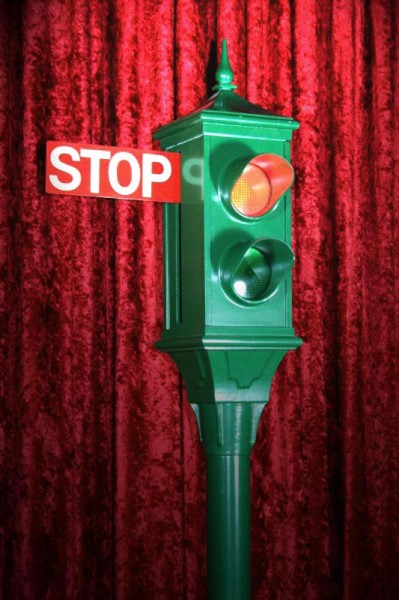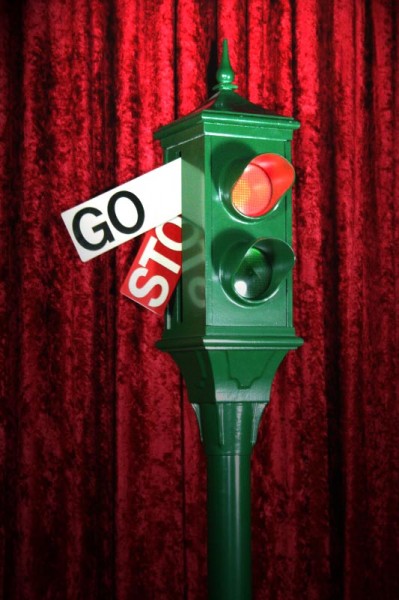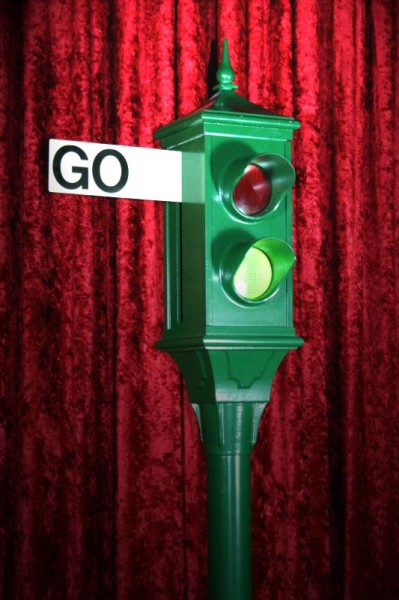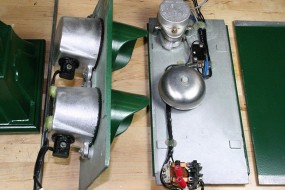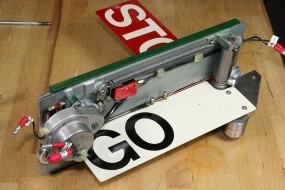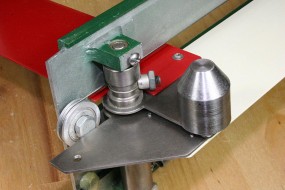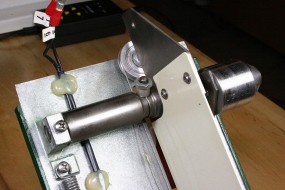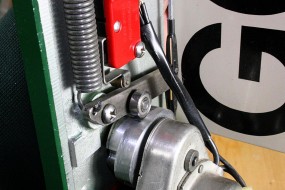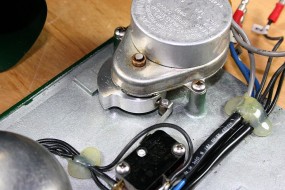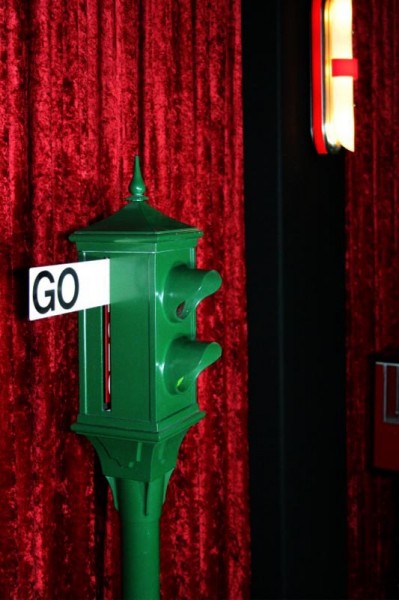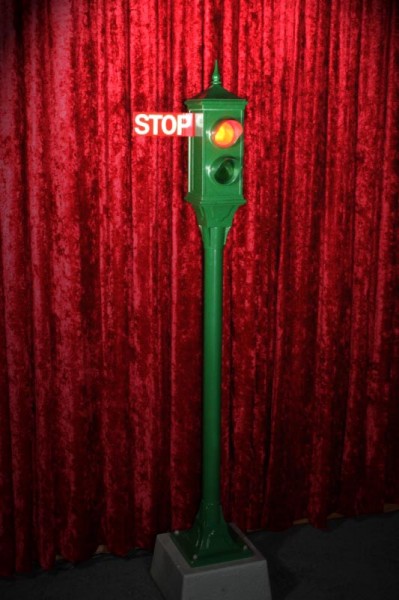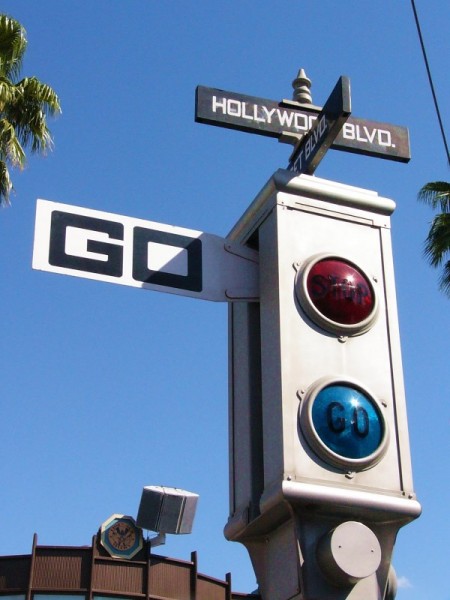Animated Semaphore Stop Light
This early metal casting project is the unfortunate result of an urgent need to build something out of poured metal without first doing the proper research into what I was making. Over the years I have managed to find a few images of real semaphore lights, and what I imagined they looked like was not really close to what I built. Anyway, it is what it is, and at least I can say that it is unique.
Out of fairness, this was made more than thirty years ago, shortly after I had caught a passing glimpse of a real one in a street scene of Spielberg’s “1941”. At this time there was no web, no Google images, and VCRs and laserdiscs were just starting to become available, so even the ability to replay a movie scene on your own tape or disk was yet to come. Even at antique shows that I frequented, such as the Chicagoland slot machine & antique advertising shows, I never saw any other than the common three-color stop lights in all the years I attended. Semaphore signals had to have been there at some time, but not when I visited.
Library research was all that I had available, but books on the history of stoplights were not exactly jumping off the shelves. I could possibly have found some patent information, but the primary intent of patent drawings is not usually to provide an accurate depiction of appearance. At this point I didn’t really care that much about any type of historical accuracy anyway; it was really just a casting project.
How It Was Made
Once a basic form was established, sandcasting patterns were made from a combination of wood, curved acrylic sheet, and sheet wax. The patterns for the hoods over the lights (which aren’t on the real semaphores) were made by pre-casting some resin in a mold made from two different sizes of Dannon yogurt cups, trimming the resin parts to shape, and then attaching them to the rest of the wood pattern. Although the mechanism was not going to be very complicated, it did require some thinking to put the screw and bearing bosses in the right places on the patterns to allow for shrinkage.
This was something like my second casting project, the first being a small part for a trade stimulator that had dazzled me for weeks prior with the awesomeness of its success. In those days the melting furnace was a simple firebrick-lined metal can, charcoal fired, and using for a blower the same canister vacuum that was used to clean the house. Charcoal is a pain to use because it burns so quickly, but it does make for some pretty showers of sparks at night.
Even with these relatively simple casting shapes, this project offered an opportunity to learn about nearly every common type of casting and mold failure. I learned about weighting molds so they don’t leak, degassing metal, avoiding moisture around molten metal, and just how easily asphalt melts and burns. Eventually all of the rough castings were completed and machined as needed.
The mechanism for moving the semaphore flags uses a steel cable stretched around pulleys such that the flags operate together – one raises when the other drops. The cable ends join at a pivoted lever with a ball-bearing that rides on a cam that is machined to provide a linear up and down motion for the follower. A fast gearmotor drives the motion cam and second cam which operates a limit switch to stop the motion either up or down.
Timing is provided by a slower gearmotor driving a separate cam and micro switch; this triggers the light to change and the flags to move every 30 seconds. A bell is connected to the actuator motor to ring at the beginning of each flag change.
The motors were picked up at a surplus store and chosen for correct RPM, but at the time I did not know about a quirk that some of these motors have. The synchronous motor itself can start spinning in either direction.
When unidirectional motion is required some are built with a little pawl that catches the rotor if it starts spinning the wrong way and causes the motor to chatter until it spins in the correct direction. This sometimes shows up as a hiccup at the start of the semaphore movement. Not all gearmotors do it, and it really is only an issue if you need smooth, unidirectional startup. You still see these bidirectional motors used (a microwave oven carousel comes to mind) where rotation direction does not matter. It’s something to be aware of when buying surplus.
The lenses were cast to size out of tinted water-clear polyester resin, and the base was cast by pouring concrete into a tapered plywood mold. I should have put a hollow cavity in it – it is much heavier than it needs to be.
I turn this on sometimes in the shop, but as quiet as it is I find it a little annoying, even with the bell turned off. By adding an ultrasonic proximity detector to trigger at a selectable distance it would make a nifty parking indicator for the end wall of a nice garage, but not mine.
Here is a the real thing- a 1930s Acme Semaphore. Up close they are huge.
At night the semaphore flags, gongs, and the stop & go lights would shut down. Extra lights located on the base casting – with lenses where the cylindrical cover is shown here – would flash red or yellow for secondary or primary streets.
Apparently due to maintenance issues the signal was not a great success at the time, which no doubt contributes to its rarity. Although the top pointed finial was intended to discourage birds from landing, they still found the flag opening to be an attractive nesting spot.
![]()

